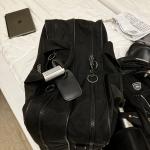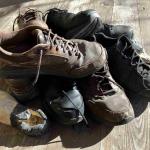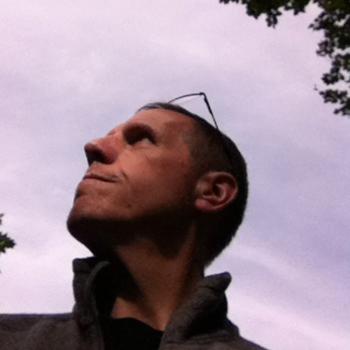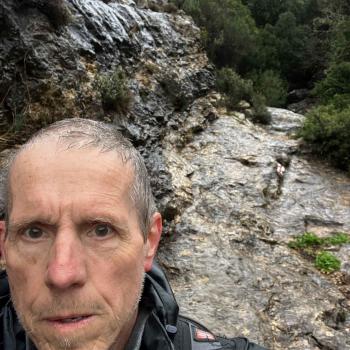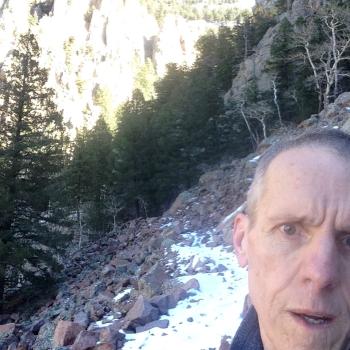Other bloggers make points; I tell stories, because pilgrim life is a never ending story. That’s fine with me, because stories are what make the Bible, the Mahabharata, the Iliad, and Paul Harvey memorable. Remember Paul Harvey? He ended his radio reports with the phrase, “and now you know the rest of the story.” Wrong Paul.
Bible, the Mahabharata, the Iliad, and Paul Harvey memorable. Remember Paul Harvey? He ended his radio reports with the phrase, “and now you know the rest of the story.” Wrong Paul.
There is no ‘rest of the story.’
True, the story I am telling now is of my pilgrim journey to Israel, which does have an end. But it is only one of eleven pilgrim journeys on five continents, the latest but hopefully not the last, which in a spiritual sense is but one journey, And now you know why this is called Pilgrim Life, not Pilgrim Days.
With that reminder, let’s resume where I ended last, at a hostel in Haifa, finally reunited with my twenty year companion suitcase.
Like all hostels, the rooms are spartan. My bed is firm, very firm, and there are two thin blankets. My shower is a drawn curtain with a drain on one side of the bathroom. All of this is fine with me, let me insist. While I will not camp out unless it is absolutely necessary, I do not need luxury. It is after dark, so I went and hunted up a shabby supper after cruising several supermarkets. If you remember, take out it not common around here. Restaurants? Plenty. Supermarkets? Several. Mostly Arab, which is true of part of America. Too much hanging meat for this vegetarian, though. Though there is a kitchen at my hostel, I am not of a mood to cook. Circling back to a convenience store, I do eventually find something to eat. What pleases me is the street life, young people meet and greet in the street itself, while little scarved grandmothers move from grocer to butcher to bakery.
Finding supper is often the one time I have to put Hebrew to use. Cashiers sometimes speak English, but not much. Thank God for Apple Pay, too. The noes ringed young woman behind the counter waves me to her, “Atah mevin anglit?” She says yes. “Todah Raba.”

Better rested, after I am sitting on the tiled piazza in the courtyard of my hostel in downton Haifa. Drinking what I thought was instant coffee, but wasn’t – surprises turn up anywhere – essentially un-French pressed coffee, a Taiwanese gentleman struck up a conversation, annoyed that at 67 he was too old for whatever lodging he had booked. I did not have the heart to tell him I was 70. Tell me, when will that kind of moment happen again?
Pilgrim life means not getting there as well as getting there.
My original plan was to spend a day here in Haifa and see Mt. Carmel where Elijah won a smackdown with Baal, and the modern Bahai Center. Unfortunately, that plan did not align with the schedule I needed, so the day in Haifa went by the wayside. As I checked in the hostel owner encouraged me to take the cable car up to the top for the view, which at night would be most pleasant. But I know my energies have been spent. On every journey I have had to relinquish some hope, some wish, some expectation. That was the theme of my last post.
Can Anything Good come out of Nazareth?
That’s an ironic question, as it comes from the gospel of John. Nathaniel says it, to which Philip replies, “Come and see.”
Returning to the patio and my gritty coffee, I am Philip on this journey, going to Nazareth. Today it is first to check in to the hostel, then take the bus back to a place along the way called Bet She’arim, which is a cemetery where Judah Ha-Nasi, the father of the Talmud, was interred. But let’s stick with events as they happened. Then I will return to Nazareth for two nights. Looking around the courtyard, remembering the vitality of last evening, smelling the sea, and still wishing to climb Mt. Carmel, I make note that if I ever come back to Israel, this is a place I want to stay a while.
Coffee done, I swing my backpack on, pick up the suitcase, grab the key and check out. At the bus stop I reached for the Ravkad card – the electronic fare card – and could not find it. Turn around, go back to the room which was still unlocked, look around, reach into pockets and such. Ah, it was in my backpack after all. Whew. Moments like this are all too frequent.
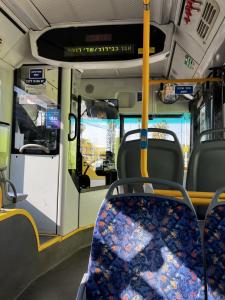 At the bus stop I join a quartet of young people who barely notice I am there. The back of one jacket has the Hebrew words, “Lech Lecha,” the words that open Abraham’s story in Genesis. It means “take yourself,” but in this context, more like “get up and go.” A young woman, apparently has her hand draped casually around the back of a tall man’s left thigh. Things I would scarcely register at home with my mind on tasks become easter eggs of awareness.
At the bus stop I join a quartet of young people who barely notice I am there. The back of one jacket has the Hebrew words, “Lech Lecha,” the words that open Abraham’s story in Genesis. It means “take yourself,” but in this context, more like “get up and go.” A young woman, apparently has her hand draped casually around the back of a tall man’s left thigh. Things I would scarcely register at home with my mind on tasks become easter eggs of awareness.
Two stops later two European folks with big backpacks get on. “Nazareth?” she says, questioning. The driver nods. We leave behind the cranes of the port, the warehouses, factories, buildings that but for their signage could be Pittsburgh or Toledo. The landscape asserts itself, looking Umbrian with green cultivated fields, rolls of khaki colored hay, large trees in copses and clumps, and those stereotypical cedars Bible illustrators love..
We climb higher and higher, the hills grow closer. Nothing looks especially Middle Eastern aside from the signs, until we get close to Nazareth which is dotted with masjids, what European languages commonly call mosques.
Traffic comes to a halt because of congestion, allowing me to take in the main street, with busy sidewalks featuring souvenir shops and bakeries. Nazareth is all about Jesus. The main street is named Paulus Hashishi, which took me a moment to realize was Hebrew for Paul VI, who visited here. Jammed with cars and pedestrians, the bus driver deftly threads this narrow needle.
Not Your Pastor’s Nazareth
American ideas of Nazareth – a village set among fields – are both romantic and outdated. Nazareth is the largest city in the Galilee, nearly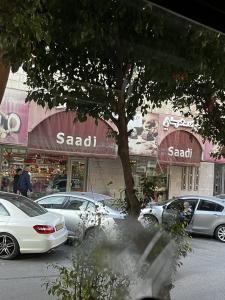 100,000, and almost entirely Arab, ⅔ Muslim and ⅓ Christian. That is the consequence of the War of Israeli Independence, which uprooted many Arab families, something they call the Nakba – the Catastrophe.
100,000, and almost entirely Arab, ⅔ Muslim and ⅓ Christian. That is the consequence of the War of Israeli Independence, which uprooted many Arab families, something they call the Nakba – the Catastrophe.
Speaking of never ending stories, for many centuries Nazareth was a small Arab Christian town (a religious community the west forgets even exists, though they are the oldest Christian communities in the world). Ruled by Rome, Byzantium, Sassanians, Muslims, Crusaders, Turks and Brits. In the first centuries CE it was one of the places Jews came after the disastrous Jewish Wars with Rome. But the Byzantines expelled the Jews – expulsion is a very old practice – in the early 7th century for supporting the Sassanians.
Nazareth sits on several hills, steep ones. This I discovered while making my way through the narrow alleys they call streets, where cars are wedged into impossible corners. Trudging up the slope with the suitcase I longed for, I retrace my steps several times as Google directions were less than precise.
This place feels like the Middle East with stone buildings built centuries ago now sprouting satellite dishes. Stone streets with water ditches in the middle, straddled by tiny automobiles. Built cheek by jowl, there is a cubist aspect to the houses, as though despite all the straight lines right angles are not permitted. No wonder Google maps had to struggle here.
I make it to my hostel, which gladly stores my suitcase while I head back down the hill to take the same bus back to Beit She’arim, literally “house of gates.” This post is now more than long enough, and Bet She’arim is worth a post of its own, so that will have to wait.

